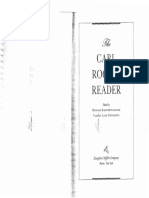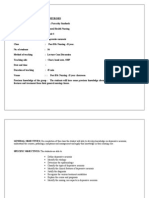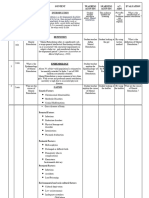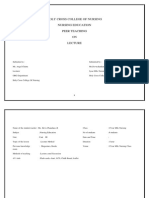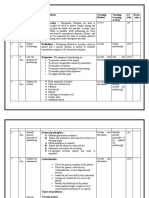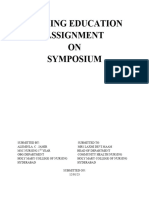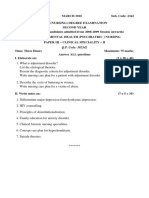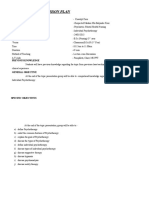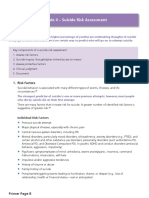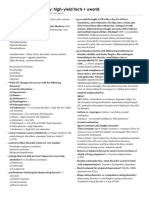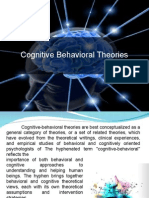Schizophrenia Lesson Plan
Schizophrenia Lesson Plan
Uploaded by
api-294223737Copyright:
Available Formats
Schizophrenia Lesson Plan
Schizophrenia Lesson Plan
Uploaded by
api-294223737Original Title
Copyright
Available Formats
Share this document
Did you find this document useful?
Is this content inappropriate?
Copyright:
Available Formats
Schizophrenia Lesson Plan
Schizophrenia Lesson Plan
Uploaded by
api-294223737Copyright:
Available Formats
Name: Jeffrey Lingard Topic: Schizophrenia Time Needed: 45 Mins
1. Identify Desired Results/Learning Outcome/Essential Question: Objective
After lecture, the successful student will be able to analyze case studies to identify positive and negative symptoms of schizophrenia, and then use
this to classify the type of schizophrenia displayed.
2. Standards:
P.6.3 Identify and describe the theories of abnormality.
P.6.4 Discuss major categories of abnormal behavior and distinguish which disorders fit under which categories DSMIV/DSM-V
3.Assessment:
Students will be assessed on participation, completion of notes, and answering chapter questions provided.
4..Co-Teaching:
One teach-One observe
5.Prior Knowledge/Connections:
Knowledge of major theories defining abnormality.
6.Lesson Introduction/Hook:
Discuss John Nash, a Nobel Prize winning mathematician who helped create Game Theory, who developed paranoid schizophrenia and claimed he
was the king of Antarctica, there was an impending alien attack, and that he was a political prisoner being held against his will. (5 mins)
7 Differentiation: Accommodation and Extension
Students will be guided in their observations to help understand the specific behaviors we are looking for.
8.Lesson Development:
Ppt lecture on schizophrenia (30 mins)
When we get to the subtypes, have students watch videos and describe the positive and negative symptoms they see
Compare to diagnostic criteria of DSM-V on next slide.
Handout 16-4 worksheet on schizophrenia (Homework if dont finish in class)
9.Specific Questioning:
How can behavior give us clues to underlying problems?
What is the frontal lobe thought to control?
How do we know there is a genetic component?
10.New Vocabulary:
Schizophrenia
Tardive dyskinesia
Catatonic
Echolalia
11.Concluding the Lesson/Closure/Debriefing:
Review the possible causes and the effects the cures (medication side-effects= tardive dyskinesia, tiredness, etc.) and how hard it is to keep
someone who is paranoid on medication. Also discuss the rule of 1/3s (1/3= little help 1/3= lots of help 1/3= cant help).
12.Materials/Resources:
PowerPoint with embedded videos
16-4 Worksheet
You might also like
- The Carl Rogers ReaderDocument28 pagesThe Carl Rogers ReaderOmar Gutiérrez67% (3)
- Integrative Harm Reduction Psychotherapy: A Case of Substance Use, Multiple Trauma, and SuicidalityDocument13 pagesIntegrative Harm Reduction Psychotherapy: A Case of Substance Use, Multiple Trauma, and SuicidalityAndrew Tatarsky100% (2)
- Module 9Document2 pagesModule 9ahsie1No ratings yet
- Person-Centered Therapy-Case ConceptualizationDocument4 pagesPerson-Centered Therapy-Case ConceptualizationDamaris Kambua100% (2)
- Bipolar Spectrum Screening Quiz: The Goldberg Bipolar Screening QuestionnaireDocument3 pagesBipolar Spectrum Screening Quiz: The Goldberg Bipolar Screening QuestionnaireIñaki Garmendia100% (1)
- Toxic ChildhoodDocument6 pagesToxic ChildhoodCourtney Green100% (1)
- Lesson Plan On Mental Health NursingDocument13 pagesLesson Plan On Mental Health NursingVarsha Rana100% (2)
- Lesson Plan - OCDDocument6 pagesLesson Plan - OCDPreeti ChouhanNo ratings yet
- Lesson Plan DepressionDocument19 pagesLesson Plan DepressionRahul Kumar Diwakar100% (1)
- Unit Plan 2nd YearDocument8 pagesUnit Plan 2nd YearPrashanth Padmini Venugopal100% (1)
- Lesson Plan DepressionDocument7 pagesLesson Plan DepressionAnnapurna Dangeti50% (2)
- Psychopathology of Racism PDFDocument15 pagesPsychopathology of Racism PDFLily EneNo ratings yet
- Course Plan of Psychiatric MSC 2003Document14 pagesCourse Plan of Psychiatric MSC 2003MonikaNo ratings yet
- Subject: Mental Health Nursing - IDocument9 pagesSubject: Mental Health Nursing - Irupali kharabeNo ratings yet
- Introduction To Self:: Time Specific Objective Content Teaching AND Learning Activity EvaluationDocument20 pagesIntroduction To Self:: Time Specific Objective Content Teaching AND Learning Activity EvaluationKiran Kour100% (2)
- Lesson Plan On Psychiatric EmergenciesDocument30 pagesLesson Plan On Psychiatric EmergenciesRajani Ashwin100% (2)
- Unit IDocument2 pagesUnit IAnat Rose TomNo ratings yet
- Lesson Plan OnresearchDocument5 pagesLesson Plan Onresearchpreet kaurNo ratings yet
- Lesson Plan On Eating DisordersDocument23 pagesLesson Plan On Eating DisordersRajani AshwinNo ratings yet
- Bhaarath College of Nursing: Lesson Plan ON SchizophreniaDocument30 pagesBhaarath College of Nursing: Lesson Plan ON SchizophreniaG.Sangeetha bnchNo ratings yet
- Mental Health Team'Document10 pagesMental Health Team'Topeshwar TpkNo ratings yet
- Lesson Plan NeuropsychaitryDocument27 pagesLesson Plan Neuropsychaitrychaitali shankar50% (4)
- Unit Plan ContentDocument9 pagesUnit Plan ContentS KANIMOZHINo ratings yet
- Dhanbad College of Nursing, Dhanbad: B.Sc. Nursing 1 YearDocument4 pagesDhanbad College of Nursing, Dhanbad: B.Sc. Nursing 1 YearjuhiNo ratings yet
- Mental Retardation Lesson PlanDocument10 pagesMental Retardation Lesson Plansp2056251No ratings yet
- LECTUREDocument31 pagesLECTUREDevuchandana RNo ratings yet
- LP - Sensory DeprivationDocument22 pagesLP - Sensory DeprivationPriya ANo ratings yet
- Lesson Plan On HeadacheDocument11 pagesLesson Plan On Headachekumarimani7037No ratings yet
- Lesson Plan PositionDocument4 pagesLesson Plan PositionDeepika Patidar100% (1)
- Lesson Plan On SymposiumDocument12 pagesLesson Plan On SymposiumAnita SinghNo ratings yet
- Process RecordingDocument9 pagesProcess RecordingShiva CharakNo ratings yet
- Lesson Plan MDTDocument21 pagesLesson Plan MDTchaitali shankarNo ratings yet
- 2 Micro Teaching Role PlayDocument8 pages2 Micro Teaching Role PlayDaneshwari SahuNo ratings yet
- Lesson Plan ON Regulatory Bodies AND Professional OrganizationDocument7 pagesLesson Plan ON Regulatory Bodies AND Professional OrganizationDebashrita Misra100% (1)
- Lesson Plan On Mental Health ActDocument7 pagesLesson Plan On Mental Health ActNeha RathoreNo ratings yet
- Unit Course MSC NursingDocument15 pagesUnit Course MSC NursingPriyanka JohnNo ratings yet
- Assignment On SymposiumDocument7 pagesAssignment On SymposiumTalari JyothiNo ratings yet
- Lesson Plan On MSEDocument9 pagesLesson Plan On MSEbandyNo ratings yet
- S.B.D.S. College of Nursing Aherwan (Ratia) Advance Nursing Practice Lesson Plan Topic: - CommunicationDocument72 pagesS.B.D.S. College of Nursing Aherwan (Ratia) Advance Nursing Practice Lesson Plan Topic: - CommunicationAnand BhawnaNo ratings yet
- Lesson Plan On SchizophreniaDocument22 pagesLesson Plan On SchizophreniaDurga Kohale100% (2)
- Presentation Nursing EducationDocument22 pagesPresentation Nursing Educationcharanjit kaurNo ratings yet
- Lesson Plan Fonn S.1Document10 pagesLesson Plan Fonn S.1Sandeep MeenaNo ratings yet
- Assignment OnDocument39 pagesAssignment OnchinuNo ratings yet
- Our Course PlanDocument19 pagesOur Course PlanAmanda ScarletNo ratings yet
- Lesson Plan On Home Visit JKSDocument4 pagesLesson Plan On Home Visit JKSjatheesh0% (1)
- 02 PT ON DepressionDocument19 pages02 PT ON Depressionamit100% (1)
- Vivekanand College of Nursing: Lesson Plan ON MotivationDocument13 pagesVivekanand College of Nursing: Lesson Plan ON Motivationnida wajidNo ratings yet
- Principles of Mental Health Nursing Standard's of Mental Health NursingDocument14 pagesPrinciples of Mental Health Nursing Standard's of Mental Health NursingSimran Josan100% (3)
- LESSON PLAN On Paedritric Nurse RolesDocument3 pagesLESSON PLAN On Paedritric Nurse Rolesbuhari rabiuNo ratings yet
- Unit Plan Subject:-PsychologyDocument3 pagesUnit Plan Subject:-PsychologyMonika SanaaNo ratings yet
- MHN.... Micro TeachingDocument45 pagesMHN.... Micro TeachingRubina Masih0% (1)
- Unit Plan of PedsDocument12 pagesUnit Plan of PedsPriya0% (1)
- Q.P. Code: 302342Document14 pagesQ.P. Code: 302342srinivasanaNo ratings yet
- AvDocument10 pagesAvMadhu BalaNo ratings yet
- Lesson Plan On ManiaDocument18 pagesLesson Plan On Maniasp2056251No ratings yet
- Evaluation of Students Performance in Clinical Practice: Objective IDocument11 pagesEvaluation of Students Performance in Clinical Practice: Objective IAMY LALRINGHLUANI M.Sc. Child Health (Paediatric ) NursingNo ratings yet
- Unit Plane Unit 2 FonDocument11 pagesUnit Plane Unit 2 Fonthakurmanu6386No ratings yet
- MENTAL HEALTH NURSING BaiaiDocument15 pagesMENTAL HEALTH NURSING BaiaiLucreatia RynjahNo ratings yet
- Lesson Plan On DeliriumDocument5 pagesLesson Plan On DeliriumAnkush Kulat Patil100% (1)
- Lesson Plan ON Critical Thinking and Problem Solving.: Era College of NursingDocument7 pagesLesson Plan ON Critical Thinking and Problem Solving.: Era College of NursingAru VermaNo ratings yet
- Era University / Era College of Nursing: Lesson Plan On-Congenital MalformationsDocument14 pagesEra University / Era College of Nursing: Lesson Plan On-Congenital MalformationsShreya Sinha50% (2)
- Lesson Plan: Previous KnowledgeDocument8 pagesLesson Plan: Previous KnowledgeSimran JosanNo ratings yet
- VESICULAR NEW Lession PlanDocument18 pagesVESICULAR NEW Lession PlanRaj JadhavNo ratings yet
- PDF Trends of Nursing Lesson PlanDocument15 pagesPDF Trends of Nursing Lesson PlanDiksha chaudharyNo ratings yet
- Mental Health NursingDocument7 pagesMental Health NursingMahida RanjitNo ratings yet
- Stage 3 - Learning PlanDocument3 pagesStage 3 - Learning Planapi-506042795No ratings yet
- Influential PsychologistsDocument4 pagesInfluential Psychologistsapi-395504895No ratings yet
- Chapter 104:: Psychocutaneous Skin Disease:: Evan Rieder & Francisco A. TauskDocument9 pagesChapter 104:: Psychocutaneous Skin Disease:: Evan Rieder & Francisco A. TauskLaras KinasihNo ratings yet
- Postpartum Obsessive Compulsive DisordersDocument9 pagesPostpartum Obsessive Compulsive DisordersAleena DavisNo ratings yet
- Suicide Risk Assessment - Pre-ReadDocument5 pagesSuicide Risk Assessment - Pre-ReadSaman HamidNo ratings yet
- The Attachment Theory Perspective On Mother-Child SeparationDocument2 pagesThe Attachment Theory Perspective On Mother-Child SeparationHarianurNo ratings yet
- Grennan 2007Document19 pagesGrennan 2007Căileanu CasianNo ratings yet
- Abnormality PsychologyDocument4 pagesAbnormality PsychologyYuen-Shan LeeNo ratings yet
- Neuropsychiatry High Yield Notes PDFDocument6 pagesNeuropsychiatry High Yield Notes PDFTolaniNo ratings yet
- Galderisi Et Al. 2015-1 PDFDocument3 pagesGalderisi Et Al. 2015-1 PDFNurul EfiliaNo ratings yet
- SIGN 131 - Management of Schizophrenia: A National Clinical Guideline March 2013Document71 pagesSIGN 131 - Management of Schizophrenia: A National Clinical Guideline March 2013Septia Widya PratamaNo ratings yet
- Running Head: Dangers and Challenges of Homelessness 1Document9 pagesRunning Head: Dangers and Challenges of Homelessness 1api-354944985No ratings yet
- Integrative Treatment of Complex Trauma (Itct) - Cheryl Lanktree and John BriereDocument10 pagesIntegrative Treatment of Complex Trauma (Itct) - Cheryl Lanktree and John Briereapi-279694446No ratings yet
- Childhood Traumas: An Outline and OverviewDocument13 pagesChildhood Traumas: An Outline and Overviewd17o100% (1)
- Psychological Disorders Lecture NotesDocument30 pagesPsychological Disorders Lecture NotesmclucieNo ratings yet
- History Taking in Psychiatry & Mental State Examination PDFDocument30 pagesHistory Taking in Psychiatry & Mental State Examination PDFMersing Haken100% (1)
- Cognitive Behavioral TheoriesDocument15 pagesCognitive Behavioral Theoriesmaria erika100% (2)
- Processes, Services, and Methods in CounsellingDocument34 pagesProcesses, Services, and Methods in CounsellingvendellajiahidalgoNo ratings yet
- International Connections Paper 1 - HLTH 1050Document2 pagesInternational Connections Paper 1 - HLTH 1050api-525321076No ratings yet
- Dissociative AmnesiaDocument12 pagesDissociative AmnesiaKimberlyLaw95No ratings yet
- Module in Educ 6a Facilitating Learner-Centered Teaching: Web: EmailDocument6 pagesModule in Educ 6a Facilitating Learner-Centered Teaching: Web: EmailyoonglespianoNo ratings yet
- Role Mental Health NurseDocument42 pagesRole Mental Health Nurseblessed23100% (2)
- ACTIVIDAD 1 - INGLES 2 - CORTE 2-Katy SaraviaDocument7 pagesACTIVIDAD 1 - INGLES 2 - CORTE 2-Katy SaraviaAnderson LopezNo ratings yet
- 2019 Social Care Awards - Feb'19Document2 pages2019 Social Care Awards - Feb'19BernewsAdminNo ratings yet
